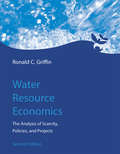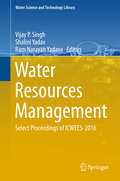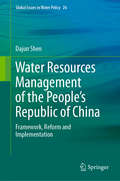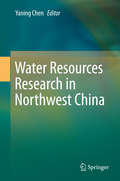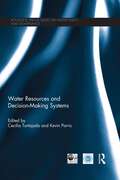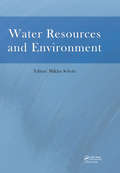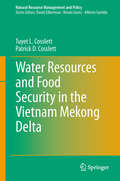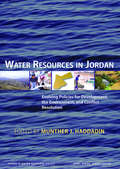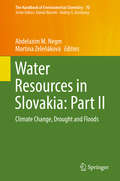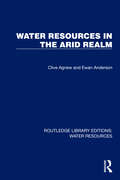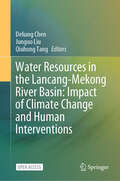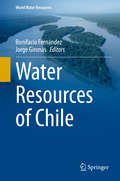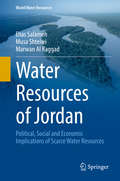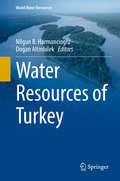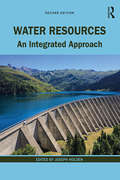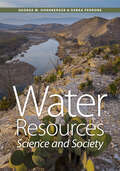- Table View
- List View
Water Resilience for Human Prosperity
by Carl Folke Johan Rockström Malin Falkenmark Carl Folke Mats Lannerstad Jennie Barron Elin Enfors Line Gordon Jens Heinke Holger Hoff Claudia Pahl-Wostl Johan Rockström Malin Falkenmark Mats Lannerstad Jennie Barron Elin Enfors Line Gordon Jens Heinke Holger HoffThe world's human population now constitutes the largest driving force of changes to the biosphere. Emerging water challenges require new ideas for governance and management of water resources in the context of rapid global change. This book presents a new approach to water resources, addressing global sustainability and focusing on socio-ecological resilience to changes. Topics covered include the risks of unexpected change, human impacts and dependence on global water, the prospects for feeding the world's population by 2050, and a pathway for the future. The book's innovative and integrated approach links green and blue freshwater with terrestrial and aquatic ecosystem functions and use. It also links changes arising from land-use alteration with the impacts of those changes on social-ecological systems and ecosystem services. This is an important, state-of-the-art resource for academic researchers and water resource professionals, and a key reference for graduate students studying water resource governance and management.
Water Resource Economics
by M. G. ChandrakanthThis book uses resource economics costing approaches incorporating externalities to estimate the returns for the country's irrigation and demonstrates how underestimating the cost of water leads farmers to overestimate profits. The importance of the subject can be judged in light of the fact that India is the largest user of groundwater both for irrigation and for drinking purposes, pumping twice as much as the United States and six times as much as Europe. Despite water's vital role in ensuring economic security for the nation and farmers alike by supporting more than 70% of food production, water resource economists are yet to impress upon farmers and policymakers the true value of water and the urgent need for its sustainable extraction, recharge and use. In an endeavor to promote more awareness, the book further delineates the roles of the demand side and supply side in the economics of irrigation, and explains how the cost of water varies with the efforts to recharge it, crop patterns, degrees of initial and premature well failure and degrees of externalities. It also discusses the importance of micro-irrigation in the economics of saving water for irrigation, estimating the marginal productivity of water and how it improves with drip irrigation, the economics of water sharing and water markets, optimal control theory in sustainable extraction of water, payment of ecosystem services for water and how India can effectively recover. In closing, the book highlights the role of socioeconomic and hydrogeological factors in the economics of irrigation, which vary considerably across hard rock areas and the resulting limitations on generalizing.
Water Resource Economics, second edition: The Analysis of Scarcity, Policies, and Projects
by Ronald C. GriffinUpdated edition of a comprehensive introduction to the economics of water management, with self-contained treatment of all necessary economic concepts.Economics brings powerful insights to water management, but most water professionals receive limited training in it. The second edition of this text offers a comprehensive development of water resource economics that is accessible to engineers and natural scientists as well as to economists. The goal is to build a practical platform for understanding and performing economic analysis using both theoretical and empirical tools. Familiarity with microeconomics or natural resource economics is helpful, but all the economics needed is presented and developed progressively in the text.The book focuses on the scarcity of water quantity (rather than on water quality). The author presents the economic theory of resource allocation, recognizing the peculiarities imposed by water, and then goes on to treat a range of subjects including conservation, groundwater depletion, water law, policy analysis, cost–benefit analysis, water marketing, privatization, and demand and supply estimation. Added features of this updated edition include a new chapter on water scarcity risk (with climate change and necessary risk tools introduced progressively) and new risk-attentive material elsewhere in the text; sharper treatment of block rates and pricing doctrine; expanded attention to contemporary literature and issues; and new appendixes on input–output analysis, water footprinting and virtual water, and cost allocation. Each chapter ends with a summary and exercises.
Water Resource Economics: The Analysis of Scarcity, Policies, and Projects
by Ronald C. GriffinEconomics brings powerful insights to water management, but most water professionals receive limited training in it. This text offers a comprehensive development of water resource economics that is accessible to engineers and natural scientists as well as economists. The goal is to build a practical platform for understanding and performing economic analysis using both theoretical and empirical tools. The mathematics needed to understand the subjects covered in this text include basic optimization methods and integral calculus. Familiarity with microeconomics or natural resource economics is helpful, but all the economics needed is presented and developed progressively in the text. Many water-based example calculations are included. Thus the book can be used for independent study as well as course work. The book focuses on the scarcity of water quantity (rather than water quality). The author presents the economic theory of resource allocation, recognizing the peculiarities imposed by water, and expands the theory to encompass time-defined matters such as ground water depletion. He then discusses such subjects as institutional economics, water law, how economics is used in policy and cost-benefit analysis, the roles of water marketing and water pricing, demand and supply estimation, privatization, and modeling with demand and supply functions. As an aid to readers with specific interests, references to recent literature are given for all of these topics. Each chapter ends with a summary and exercises. All graphic portrayals of economic theory and most calculations are performed using Mathematica software. These programs are downloadable, but their use is entirely optional.
Water Resource Management
by David E. McnabbThis book is about how water managers in the United States are responding to the call for increased effort to achieve sustainable supplies of clean fresh water for present and future generations. The author, himself a participant in the water supply chain, demonstrates that while water is indeed one of life's most essential commodities, in many parts of the United States it is one of the most stressed resources. Throughout the book the author illustrates both the good and the bad efforts taken or not taken by water and wastewater management with real life examples. This book will appeal to the educators, students, volunteers, elected officials, regulators, and other participants with a role in helping the suppliers of water and wastewater services to achieve their goals providing clean, safe water on a sustainable basis.
Water Resource Systems Planning and Management
by Daniel P. Loucks Eelco BeekThis book is open access under a CC BY-NC 4. 0 license. This revised, updated textbook presents a systems approach to the planning, management, and operation of water resources infrastructure in the environment. Previously published in 2005 by UNESCO and Deltares (Delft Hydraulics at the time), this new edition, written again with contributions from Jery R. Stedinger, Jozef P. M. Dijkman, and Monique T. Villars, is aimed equally at students and professionals. It introduces readers to the concept of viewing issues involving water resources as a system of multiple interacting components and scales. It offers guidelines for initiating and carrying out water resource system planning and management projects. It introduces alternative optimization, simulation, and statistical methods useful for project identification, design, siting, operation and evaluation and for studying post-planning issues. The authors cover both basin-wide and urban water issues and present ways of identifying and evaluating alternatives for addressing multiple-purpose and multi-objective water quantity and quality management challenges. Reinforced with cases studies, exercises, and media supplements throughout, the text is ideal for upper-level undergraduate and graduate courses in water resource planning and management as well as for practicing planners and engineers in the field.
Water Resources Management
by Vijay P Singh Shalini Yadav Ram Narayan YadavaThis book contains two parts. The first part deals with some aspects of irrigation, encompassing farm irrigation systems, landscape gardening, energy assessment for drip irrigation, and micro-sprinklers. The second part is on water resources planning and management. It discusses water crisis, challenges in river health management, water supply systems, salt water intrusion, lake management, water supply demand assessment, integrated water resources management, among other topics. The book will be of interest to researchers and practitioners in the field of water resources, hydrology, environmental resources, agricultural engineering, watershed management, earth sciences, as well as those engaged in natural resources planning and management. Graduate students and those wishing to conduct further research in water and environment and their development and management may find the book to be of value.
Water Resources Management Sustaining Socio-Economic Welfare
by Phoebe Koundouri Nikos A. PapandreouThe aim of this book is to offer a river-basin management plan which is directly implementable and consistent with the European Union -Water Framework Directive (EU WFD). The contributors, who are leading world experts in their respective fields, develop an integrated water resources management plan for the Asopos river basin in Greece which is economically efficient, socially equitable and environmentally sustainable. The program offers explicit technical and investment solutions, socioeconomic and legal instruments and recommendations for institutional restructuring. The introductory chapter describes the water situation in Greece and assesses the potential of timely implementation of the EU WFD. Special emphasis is given to the cost-recovery principle. Chapter 2 introduces the case study area highlighting the particular pressures and impacts as well as the environmental functions and values of Asopos River and Oropos Lagoon. Chapters 3 and 4 focus on the economic characterisation of Asopos River Basin in order to identify the economic sectors and social groups that will bear the cost and benefits of the implementation of the EU WFD. In particular, Chapter 3 presents the main water uses and pricing for water supply in the industrial and the agricultural sectors. Chapter 4 completes the baseline appraisal, presenting the details of water use by the residential and touristic sectors. The following chapters assess valuation and decision-making tools from a range of perspectives, including agricultural needs, valuing the impacts of industrial activity, the costs and benefits of environmental preservation and management. The water resources management plan is presented in Chapter 9; the concluding chapter offers recommendations on institutional changes and presents the lessons learned as resources applicable to other river basins in Greece and elsewhere. The book applies state-of-the art market and non-market valuation methods to estimate water demands in the residential, industrial, agricultural, tourism, environmental and health sectors and to balance these, over time and space, with water supply. Given the well-known challenge of managing natural resources in a way that maximizes and sustains social welfare, this book will provide an invaluable point of reference for applied researchers and policy makers working in water resources management.
Water Resources Management of the People’s Republic of China: Framework, Reform and Implementation (Global Issues in Water Policy #26)
by Dajun ShenThis book explores water resources management issues in China and possible solutions. It analyzes a wide range of general and specific topics, providing case studies and a balanced review of the past and present situation as well as future developments. The book begins with a general introduction and an overview of hydrology, water resources, and development issues in China. It then presents a management framework, including a management system, management institutions, river basin management, water pricing, water rights, and groundwater management, and discusses its implementation, covering water resources allocation and regulation in the Yellow River, integrated water affair management reforms, and agricultural water management in northern China. The last section focuses on the current reforms and hot topics, with strong emphasis on stringent water resource strategies applied to the river and lake principle system, recycled water use and water resources asset management, as well as climate change impacts, and concludes with a summary of the many changes in the water sector in China and a look at the road ahead and the areas that still need to be reformed.
Water Resources Planning and Management
by Karen Hussey R. Quentin GraftonWater is an increasingly critical issue at the forefront of global policy change, management and planning. There are growing concerns about water as a renewable resource, its availability for a wide range of users, aquatic ecosystem health, and global issues relating to climate change, water security, water trading and water ethics. This handbook provides the most comprehensive reference ever published on water resource issues. It brings together multiple disciplines to understand and help resolve problems of water quality and scarcity from a global perspective. Its case studies and 'foundation' chapters will be greatly valued by students, researchers and professionals involved in water resources, hydrology, governance and public policy, law, economics, geography and environmental studies.
Water Resources Planning and Management
by Karen Hussey R. Quentin GraftonWater is an increasingly critical issue at the forefront of global policy change, management and planning. There are growing concerns about water as a renewable resource, its availability for a wide range of users, aquatic ecosystem health, and global issues relating to climate change, water security, water trading and water ethics. This handbook provides the most comprehensive reference ever published on water resource issues. It brings together multiple disciplines to understand and help resolve problems of water quality and scarcity from a global perspective. Its case studies and 'foundation' chapters will be greatly valued by students, researchers and professionals involved in water resources, hydrology, governance and public policy, law, economics, geography and environmental studies.
Water Resources Research in Northwest China
by Yaning ChenThis book examines the possible impacts of climate change on hydrology and water resources in the vast arid region of Northwest China, which is one of the world's largest arid places. The first chapter offers an introductory discussion of the physical geography and socioeconomic conditions in the region. Chapters 2 through 7 discuss the climate system and hydrologic system changes in the region, and assess some implications of these changes in relation to potential evapotranspiration, the hydrological cycle and spatiotemporal variations of the snow cover and glaciers as measured via remote sensing, geographic information systems, and statistical analysis. Chapters 8 and 9 focus on model description and experimental design for interpreting the hydro-climatic process, emphasizing the integration of water, climate, and land ecosystems through field observations and computer-based simulations. Chapter 10 examines some extreme hydrological events and presents a study using the historical trend method to investigate the spatial and temporal variability of changing temperature and precipitation extremes in the hyper-arid region of Northwest China. A concluding chapter discusses possible strategies for sustainable watershed management. The contributors are acknowledged experts who bring broad, relevant experience on water resources research in China's cold and arid regions. The lessons of this volume will prove useful for understanding arid areas elsewhere in the world.
Water Resources and Decision-Making Systems (Routledge Special Issues on Water Policy and Governance)
by Cecilia Tortajada Kevin ParrisWater data and information are essential to support efforts to understand, manage, allocate, utilize and protect water resources. The linkages between Water Information Systems and needs of decision makers are complex, but can be encapsulated in a Driving Force (Policy Needs) – Monitoring – Data Management – Reporting framework. The rapid development in water policy reforms in many sectors and growing emphasis on demand-side policy solutions to water resources management has created an information imbalance. This imbalance can be characterised in terms of an inverted pyramid with implementation of many water policy initiatives supported by little data and information, especially related to economic and financial elements, to help guide decision makers toward more effective and efficient water resources management strategies. Additionally, as stress and demands on water systems increase and water becomes a more valued resource, this tends to increase the value of water information both for water providers and users. Nevertheless, many countries are reporting that the capacity to collect water information is being undermined by a lack of resources, while expertise to collect, analyse and interpret water data for decision makers is being lost. Finally, the impact of climate change on hydrological regimes represents a key potential stress on water systems. This issue could be the catalyst for adapting policies to provide more efficient and effective use and management of water resources and advance institutional and governance reforms in the water sector.This book is based on a special issue of the International Journal of Water Resources Development.
Water Resources and Environment: Proceedings of the 2015 International Conference on Water Resources and Environment (Beijing, 25-28 July 2015)
by Miklas ScholzThe 2015 International Conference on Water Resource and Environment (WRE2015) aims to provide a platform where scholars from different countries can exchange ideas, opinions and views. This book is divided into four main themes:1. Hydrology and water resources;2. Water pollution; 3. Water treatment methods, and4. Freshwater ecosystems. Exploring to
Water Resources and Food Security in the Vietnam Mekong Delta
by Tuyet L. Cosslett Patrick D. CosslettThe Mekong River has been a main source of conquest, conflict, and cooperation in the Southeast Asian region. Much has been written on the vital and critical importance of the Mekong River fresh water to the sustainable economic development of the Mekong Delta. This book selects the Mekong Delta as a case study of regional cooperation for water and food security for not only for Vietnam but also for the world in a new century of global economy. It focuses not only on the Mekong Delta as an integral part of the River but also on Can Tho City and its 12 provinces that produce over 50 percent of the country's rice output and 60 percent of total fishery output. The book takes a micro approach to examine how each province is adapting to the twin threats of mainstream dams construction and climate change, reducing fresh water flows and increasing saline infusions on its present and future economy. Finally, it reviews the roles of international institutional arrangements, namely the Mekong Committee and the Mekong River Commission, in promoting regional cooperation among the riparian states for political and economic development of the Mekong Delta.
Water Resources in Jordan: Evolving Policies for Development, the Environment, and Conflict Resolution
by Munther J. HaddadinThis is the first comprehensive, multi-disciplinary book to address water policy in Jordan. Edited by the former Minister of Water and Irrigation of Jordan, with contributions by other prominent Jordanian and international water professionals, this volume covers such areas as the population-water resources equation in Jordan; institutional and legal frameworks; the data systems used for the assessment and formulation of water policy; water allocations and uses in municipal, industrial, and agricultural sectors; social and environmental issues; and water conflict with Jordan's neighbors. The book is a must for readers interested in Middle East politics and the critical nature of water issues in the region. The book notes the importance of interaction with the outside world to augment water resources through trade, making the experience of Jordan relevant to other developing regions where water is scarce. It introduces the term 'shadow water' to mean the scarce indigenous water resources that the import of agricultural and industrial commodities saves or replaces. The book shows how financially profitable it can be to treat water as a tradable commodity, to be exchanged peaceably across international borders. Haddadin and his distinguished contributors bring the water conflicts between Jordan and its neighbors, Israel and Syria, into sharp focus. The book includes a historical perspective on the development of water policies in Jordan and explores the significance of water in the religious, social, and political life of the country.
Water Resources in Slovakia: Climate Change, Drought And Floods (The Handbook of Environmental Chemistry #70)
by Martina Zeleňáková Abdelazim M. NegmThis book offers up-to-date information on the impact of climate change on water resources in Slovakia, the occurrence of drought and floods, hazards and protection methods. The topics covered include hydrological extremes, such as droughts and flood, in Slovakia; risk assessment and protection; sustainable management; and water management in buildings. The closing chapter provides general conclusions and recommendations for future research. It appeals to graduate students and researchers as well as to decision makers involved in planning future water resources in Slovakia.
Water Resources in the Arid Realm (Routledge Library Editions: Water Resources)
by Ewan Anderson Clive AgnewOriginally published in 1992, this book dispels some of the myths that surround water resource problems of arid lands and the notion that there are simple ‘once and for all’ solutions. Population growth, industrialization, environmental mismanagement and land degradation have led to droughts, poverty and famine with the result that the need for space, food and key natural resources such as water has become the most critical issue in global development. Nowhere is this crisis more apparent than in arid lands, where water resources provide the key to economic and environmental development. The authors argue that as the arid land environment is highly variable the key to success is flexibility. The book is divided into four sections, dealing with the geography of the arid realm; the water resource problems they face: the methods available for enhancing water supplies and finally, management of this resource. The book will be of use to undergraduate and postgraduate student and for those actively engaged in the development of arid land water resources.
Water Resources in the Lancang-Mekong River Basin: Impact of Climate Change and Human Interventions
by Qiuhong Tang Deliang Chen Junguo LiuThis open access book provides a comprehensive, up-to-date picture of the current state of knowledge covering climate change, surface water change, arsenic pollution, water utilization, water-food-energy nexus, water related hazards, water management, and water governance in the Lancang-Mekong River Basin. Considering the widely concerned fact that the climate change and human intervention induced impacts on water will bring unprecedented threats to human societies and ecosystems, the book intends to support UN’s sustainable development goals through sustainable use of water by providing the most accurate and updated information on climate and water changes in a consistent way. Underlying all aspects of the book is a strong commitment to assessing the science comprehensively, without bias and in a way that is relevant to policy but not policy prescriptive. It can provide implications to support decision-makers and stakeholders for integrated water resources management and sustainable development at all levels.
Water Resources of Chile (World Water Resources #8)
by Bonifacio Fernández Jorge GironásChile is a privileged country in terms of water resources, with an average annual runoff of approximately 50,000 m3/person. However, water availability varies enormously in space, as less than 1,000 m3/person are available for more than 50% of the population. The temporal and spatial distribution of water resources is driven by processes highly variables across a country with different climates explained not only by a large range of latitudes (from 17° to 56° south), but also the presence of the Pacific Ocean and the Andes with peaks up to 7000 m. This geography makes of Chile a true natural laboratory in which water is essential for the society and the economy of the country. The relevance of water resources for the country has become even more significant in the context of a mega-drought that has affected practically the entire territory in recent years, although large floods such as those in Atacama 2015 and 2017 also take place periodically. This unique book brings together the state-of-art knowledge about the hydrology of Chile and its water resources, with a particular focus on quantitative aspects. The chapters are prepared by many of the most relevant researchers and practitioners working in water resources in the country. High-quality research contributions on climate and meteorology, surface and subsurface hydrology, water quality, water monitoring, water resource and global change, among other issues, are presented in this unique book, which offers a useful guide for academicians, researchers, practitioners and managers dealing with diverse water-related issues in Chile and other regions with similar characteristics
Water Resources of Jordan: Political, Social And Economic Implications Of Scarce Water Resources (World Water Resources #1)
by Elias Salameh Musa Shteiwi Marwan Al RaggadThis book gives a detailed account of the scarce water resources of Jordan, with a focus on their quantities, quality, and use for different sectors. It details the political, social, and economic dimensions of the scarce water resources along with their implications on Jordan's cooperation with its neighbors. The book includes implemented projects of dams, canals, water supply networks, waste water treatment, and more. It gives an overview of which projects have been successful and which have failed to achieve their purposes and why. Shared water with other countries and their developmental implications to the water sector are discussed and future water supply projects, such as the Red Sea-Dead Sea conduit project, are elaborated on. The book also touches upon the waves of refugees and their impact on the water sector and water strategies in Jordan.
Water Resources of Turkey (World Water Resources #2)
by Dogan Altinbilek Nilgun B. HarmanciogluThis book provides an in-depth description of water resources of Turkey, a country with a unique geographical location, extending from the Mediterranean in Europe to the Middle East. Its varying geography, topography, hydrology, geology and climate are reflected in the diverse characteristics of its water basins. Furthermore, due to its geographical location, Turkey has a significant number of transboundary river basins and has to share its water resources with its neighbors, an issue that can sometimes lead to water conflicts.Turkey is also an interesting example of a developing country that is attempting to adapt to universal water management strategies while at the same time facing legal, institutional, economic and capacity development problems. It has long remained a water-rich country, but the situation is now changing due to the increasing population, inefficient use of resources, and the impacts of climate change and environmental degradation.This book is useful for national and international organizations as well as water resources professionals. It takes on an added significance in the light of climate change in the region, water management problems and transboundary water basins.
Water Resources: An Integrated Approach
by Joseph HoldenThe world faces huge challenges for water as population continues to grow, as emerging economies develop and as climate change alters the global and local water cycle. There are major questions to be answered about how we supply water in a sustainable and safe manner to fulfil our needs, while at the same time protecting vulnerable ecosystems from disaster. Water Resources: An Integrated Approach provides students with a comprehensive overview of both natural and socio-economic processes associated with water. The book contains chapters written by 20 specialist contributors, providing expert depth of coverage to topics. The text guides the reader through the topic of water starting with its unique properties and moving through environmental processes and human impacts upon them including the changing water cycle, water movement in river basins, water quality, groundwater and aquatic ecosystems. The book then covers management strategies for water resources, water treatment and re-use, and the role of water in human health before covering water economics and water conflict. The text concludes with a chapter that examines new concepts such as virtual water that help us understand current and future water resource use and availability across interconnected local and global scales. This book provides a novel interdisciplinary approach to water in a changing world, from an environmental change perspective and inter-related social, political and economic dimensions. It includes global examples from both the developing and developed world. Each chapter is supplemented with boxed case studies, end of chapter questions, and further reading, as well as a glossary of terms. The text is richly illustrated throughout with over 150 full colour diagrams and photos.
Water Resources: An Integrated Approach
by Joseph HoldenNow in its second edition, Water Resources: An Integrated Approach provides students with a comprehensive overview of natural processes associated with water and the modifications of these processes by humans through climate change and land management, water-related health issues, engineering approaches to water and socio-economic processes of huge importance to water resources. The book contains chapters written by 24 specialist contributors, providing expert depth of coverage to topics. The text introduces the basic properties of water and its importance to society and the nature of the different regional imbalances between water resource availability and demand. It guides the reader through the changing water cycle impacted by climate and land management, water flows in river basins, surface water quality, groundwater and aquatic ecosystems, and covers the role of water in human health and associated hazards before turning to engineering solutions to water and wastewater treatment and reuse. The book deals with physical and social management strategies required for water resource planning, the economics of water and treatment of issues associated with conflict over water. The concept of virtual water is covered before the text concludes with a chapter considering the challenges of predicting future water issues in a rapidly changing world and where environmental systems can behave in a non-linear way. The need to work across disciplines to address challenges that are connected at both local and global scales is highlighted. Water Resources also includes global examples from both the developing and developed world. There are 58 case study boxes. Each chapter is supplemented with these case studies and with reflective questions, project ideas and further reading, as well as links to a glossary of terms. The book is richly illustrated throughout with over 160 full-colour diagrams and photographs. The text provides a novel interdisciplinary approach to water in a changing world, from an environmental change perspective and interrelated social, political and economic dimensions. It will be an indispensable guide to undergraduates studying Water Resources and Management, Geography of Water, and Water in the Environment.
Water Resources: Science and Society
by George M. Hornberger Debra PerroneA scientifically rigorous text grounded in socioeconomic reality that examines both physical hydrology and contemporary water usage issues.The fair allocation and wise use of fresh water presents significant challenges across the world. To avoid unresolvable crises in the future, judiciously managing water resources in the twenty-first century is fundamentally important. Integrating the underlying science of hydrology with real-world usage scenarios, Water Resources offers a nuanced, modern treatment of contemporary water resource management issues.In this ground-breaking new text, renowned environmental scientist and educator George M. Hornberger and award-winning environmental engineer Debra Perrone examine the role of water resources in natural, social, and human-built systems, helping students understand and evaluate the complex tradeoffs required to achieve sustainable water management. Providing a much-needed educational tool that looks at freshwater resources within the context of the crucial water-energy-food nexus, the text • includes a primer on the elements of physical hydrology necessary to understand resource availability; • covers rivers, lakes, groundwater, and soil water;• relates water to agriculture, energy, urbanization, and the environment;• highlights connections between water quantity and quality; • explains the economic and legal constraints around water resources; • considers the impacts of climate change and population growth; and• proposes paths forward for the sustainable use of water.Teaching basic methods used to make informed water management decisions, the book includes illustrative quantitative calculations, qualitative think-pieces, and case studies. An appendix provides a review of units, dimensions, and conversions useful for addressing each chapter's example problems. Online answer keys are also available.Positioned to become the foremost text on water resource issues, this companion to Hornberger's widely regarded Elements of Physical Hydrology reveals the enormity of the water crisis facing the planet while offering realistic hope.


